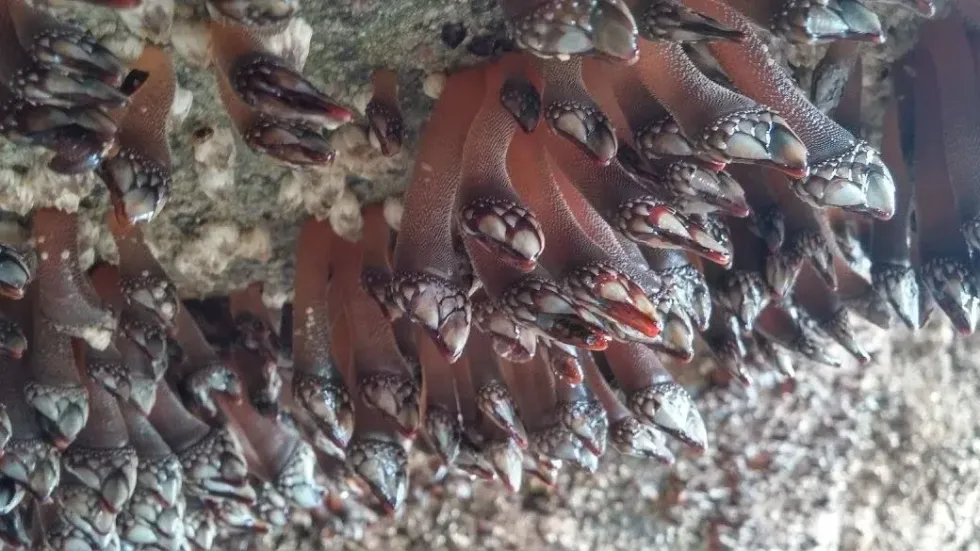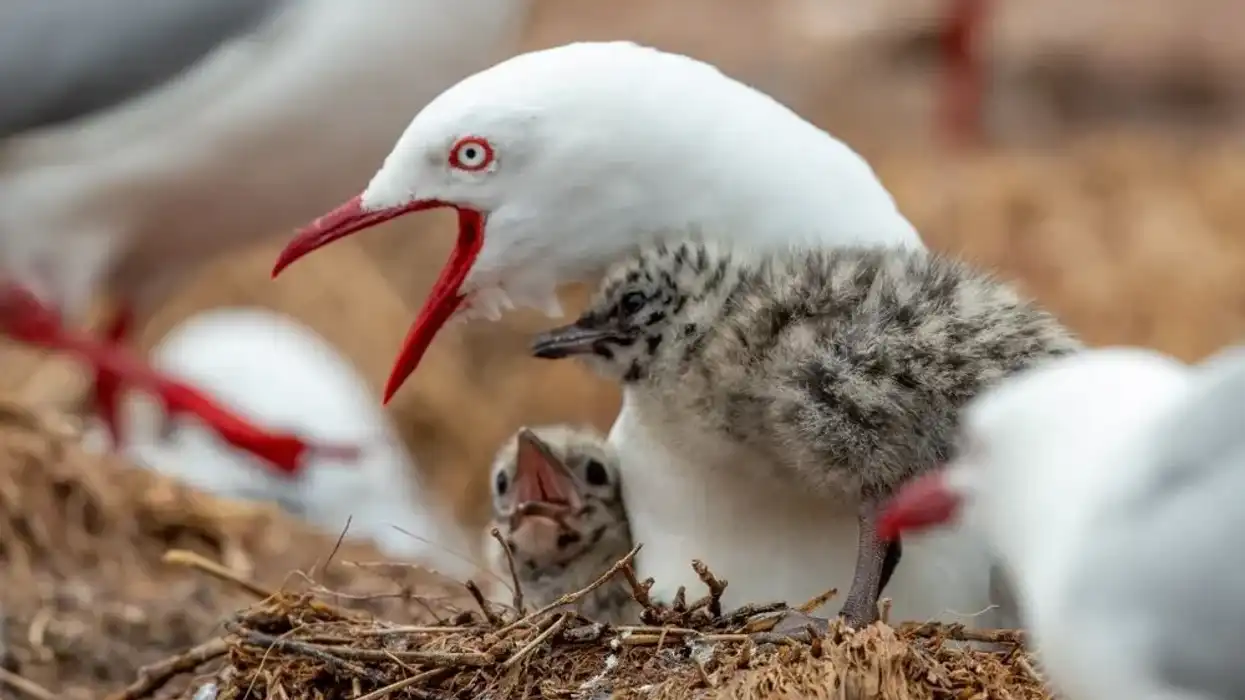Have you ever heard of creatures that stand on their head and eat through their legs? Sounds weird, right? Well, to your utter surprise, there are creatures called goose barnacles that live like that.
The goose barnacle is a crustacean that belongs to the order Pedunculata and phylum Arthropoda. Other common names include gooseneck barnacles or stalked barnacles, or smooth neck goose barnacles. They are found in the intertidal zone that lives attached to hard surfaces like rocks and debris. Some common goose barnacles (percebes) are Pollicipes pollicipes, Lepas anserifera, and Pollicipes polymerus.
In the past, people did not know that birds migrate and made assumptions that from this crustacean through spontaneous generation formed the barnacle geese since the barnacle geese never nest in the temperate regions of Europe and their yearly appearance was in fall. Consequently, the English names goose barnacle and barnacle goose came into being.
Interesting, right? Read further to know more about this peculiar creature. Also, read about the Luna moth and the common wasp.
Goose Barnacle Interesting Facts
What type of animal is a goose barnacle?
Gooseneck barnacles are filter-feeding crustaceans that live in the oceans' intertidal zone. They are found attached to hard surfaces. With the help of their fleshy stalk, they can attach themselves to any hard surface. The presence of calcareous plates helps to protect the body and the internal organs.
As they keep on growing, they develop new plates. When the barnacles are first secreted, the plates look lustrous and iridescent. After constant washing by high tides and battering waves, these shells become weird and dull.
What class of animal does a goose barnacle belong to?
The goose barnacles are arthropods. They belong to the class Maxillopoda, phylum Arthropoda, and the family Podicipedidae.
How many goose barnacles are there in the world?
The exact number of gooseneck barnacles is not known. However, there are around 1,400 species of barnacles found in the world.
Where do goose barnacles live?
The barnacles live in the marine and saltwater oceans in the intertidal zone and the deep sea. The barnacles are found attached to the hard surfaces at all latitudes and depths. The gooseneck barnacles are found in the UK, Australia, northeastern Pacific Ocean, southern Alaska, Baja California.
What is a goose barnacle's habitat?
The barnacles prefer marine and saltwater oceans and are often found living attached to the rocks, ships, rubble in the intertidal zone, and the deep sea. In the intertidal region, during low tide, the barnacles spend theirs without any water around them. These percebes have even been spotted on a chunk of spaceship spotted in the Isles of Sicily.
Who does goose barnacle live with?
The gooseneck barnacles live in packs of their kind.
How long does a goose barnacle live?
Gooseneck barnacles can live up to 20 years or more.
How do they reproduce?
The gooseneck barnacles are hermaphrodites, which means that they have both male and female sex organs. But to reproduce, they need to be fertilized by their neighbor.
A retractable tube that contains sperm can reach outside the shell as far as a few inches to reach its neighboring barnacle to fertilize. When they are ready to hatch, the newborn barnacles will fall from the rock perches.
The newborn barnacles pop out as one-eyed larvae from their parents' shells. The newborn barnacles feed on plankton and shrimp-like larvae. These larvae find a new home, and hence the life cycle continues.
What is their conservation status?
The conservation status of the gooseneck barnacle is Not Evaluated.
Goose Barnacle Fun Facts
What does a goose barnacle look like?
The gooseneck barnacles are weird-looking, sci-fi creatures. It is 4 in (10 cm) long and weighs around 3 lb (1.4 kg). They are also known as gooseneck barnacles because they have a long fleshy stem that resembles a black neck. They have a white triangular head and calcareous plates to protect the body.
The shells look pale-purple. The head is attached to a hard surface in the shape of Y. If they were 10 ft (3 m) tall, they would look creepy as they look like dinosaurs' feet.
How cute are they?
No, the percebes are not cute. Instead, they are ugly and look like dinosaur's feet.
How do they communicate?
Since the barnacle is a crustacean, it is known to communicate with the help of chemical signals. For example, it uses chemical signals for finding mates; the larvae find their kind for settling down and parent-offspring communication.
How big is a goose barnacle?
The goose barnacle is 4 in (10 cm) long. The goose barnacle's size is five times bigger than the Acorn barnacle.
How fast can a goose barnacle move?
The adult gooseneck barnacles are sessile crustaceans; they can't move. Only the larvae move around for a short phase and finally settle down. After that, it attaches itself to a hard surface and never moves.
How much does a goose barnacle weigh?
The goose barnacle weighs around 3 lb (1.4 kg). The more the barnacles eat, the more they grow.
What are the male and female names of the species?
Female species are female goose barnacles, and the male species is known as male goose barnacles.
What would you call a baby goose barnacle?
Baby goose barnacles are called nauplius and the cyprid.
What do they eat?
The goose barnacles filter feeds on plankton, diatoms, large crustaceans, crabs, shrimp, mollusks, copepods, krill, and detritus with their adapted fan-like feet.
They have feather-like appendages called cirri to feed through. As the cirri open and close, they trap microscopic organisms from the water. Then, if they sense a threat, they quickly hide in their protective shells.
Are they poisonous?
No, the goose barnacles are not poisonous. Humans eat them.
Would they make a good pet?
No, the goose barnacles are not kept as pets. But, they are cultivated for commercial purposes.
Did you know...
Like lobsters, barnacles also shed their shell, and it gets small. However, since they do not leave their homes, they must build up the current ones. It is believed that they build up with the help of the chemical secretion of new materials from the outside.
The percebes are around $80 per lb. The gooseneck barnacles or percebes are very expensive because they are delicious and the taste is somewhere between lobster and clam.
The other reason is that gathering them is very risky, and it involves controversial work. Also, maybe because they are harvested in a place called Costa da Morte (the Coast of Death) in Galicia.
Acorns are more closely packed on the rocks and look like miniature volcanoes. The stalked barnacles have a soft stem and a shell at the top for protection.
They are found floating on the sea before finally, they attach themselves to a hard substance. No one is certain as to which barnacle came first. But it is believed that the barnacle (goose) had the name first.
Can you eat goose barnacles?
Yes, you can eat goose barnacles. In Spain and Portugal, it is considered a rare dish. It tastes like something in between lobster and clam. In Europe, it costs around $500 per kg.
What are goose barnacles used for?
The goose barnacles are used as food. In Portugal and Spain, the Pollicipes pollicipes are consumed as a rare delicacy.
They are commercially harvested on the northern coast of the Iberian Peninsula, mainly in Asturias and Galicia, and Alentejo (southwestern coast of Portugal). It is also widely distributed in Morocco and is even imported. Even until 1999, the Pollicipes polymerus was imported from Canada to Spain.
In Spain, the percebes are slightly boiled in brine and served hot. To eat percebes, you will have to first squeeze the foot between the thumb and finger, and also, you must pull the inner tube out.
Next, the claw is removed, and then the flesh is eaten. It is believed that the native people of California also eat the stem after cooking it in a hot ember.
Here at Kidadl, we have carefully created lots of interesting family-friendly animal facts for everyone to discover! Learn more about some other arthropods from our mayfly facts and bee facts pages.
You can even occupy yourself at home by drawing one on our free printable goose barnacle coloring pages.








